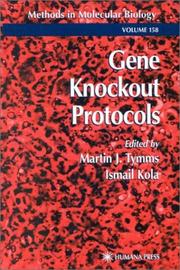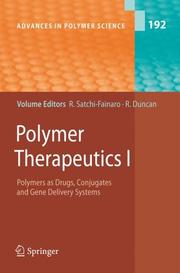| Listing 1 - 9 of 9 |
Sort by
|
Book
ISBN: 1316781674 1316781909 1316623343 131677144X 1316782131 1316783057 1316782360 1316780295 9781316771440 9781316783054 9781316782361 9781316623343 9781107172166 1107172160 Year: 2016 Publisher: New York
Abstract | Keywords | Export | Availability | Bookmark
 Loading...
Loading...Choose an application
- Reference Manager
- EndNote
- RefWorks (Direct export to RefWorks)
Would you change your genes if you could? As we confront the 'industrial revolution of the genome', the recent discoveries of Crispr-Cas9 technologies are offering, for the first time, cheap and effective methods for editing the human genome. This opens up startling new opportunities as well as significant ethical uncertainty. Tracing events across a fifty-year period, from the first gene splicing techniques to the present day, this is the story of gene editing - the science, the impact and the potential. Kozubek weaves together the fascinating stories of many of the scientists involved in the development of gene editing technology. Along the way, he demystifies how the technology really works and provides vivid and thought-provoking reflections on the continuing ethical debate. Ultimately, Kozubek places the debate in its historical and scientific context to consider both what drives scientific discovery and the implications of the 'commodification' of life.
Gene targeting. --- Genomes. --- Genetics --- Genomics --- Haploidy --- Targeting, Gene --- Genetic engineering

ISBN: 0124660444 9780124660441 1281119210 9781281119216 9786611119218 6611119213 1435616766 9781435616769 0080532365 9780080532363 0124660452 0124660460 Year: 1998 Publisher: San Diego : Academic Press,
Abstract | Keywords | Export | Availability | Bookmark
 Loading...
Loading...Choose an application
- Reference Manager
- EndNote
- RefWorks (Direct export to RefWorks)
The FactsBooks Series has established itself as the best source of easily-accessible and accurate facts about protein groups. Described as ""a growing series of excellent manuals"" by Molecular Medicine Today, and ""essential works of reference"" by Trends in Biochemical Sciences, the FactsBooks have become the most popular comprehensive data resources available. Using an easy-to-follow format and drawing from meticulous research, the Factsbooks will keep you up-to-date with the latest advances in structure, amino acid sequences, physicochemical properties, a
Human genetics --- Basic Sciences. Genetics --- Gene targeting --- Mice --- Mice, Knockout --- Proteins --- Transgenic mice --- Genetics (General). --- Genetics --- genetics --- Targeting, Gene --- Genetic engineering --- Transgenic animals
Book
ISBN: 1108622100 1108597106 1108695094 9781108597104 9781108695091 1108454623 9781108454629 Year: 2018 Publisher: [Place of publication not identified] CAMBRIDGE UNIV Press
Abstract | Keywords | Export | Availability | Bookmark
 Loading...
Loading...Choose an application
- Reference Manager
- EndNote
- RefWorks (Direct export to RefWorks)
Would you change your genes if you could? As we confront the 'industrial revolution of the genome', the recent discoveries of Crispr-Cas9 technologies are offering, for the first time, cheap and effective methods for editing the human genome. This opens up startling new opportunities as well as significant ethical uncertainty. Tracing events across a fifty-year period, from the first gene splicing techniques to the present day, this is the story of gene editing - the science, the impact and the potential. Kozubek weaves together the fascinating stories of many of the scientists involved in the development of gene editing technology. Along the way, he demystifies how the technology really works and provides vivid and thought-provoking reflections on the continuing ethical debate. Ultimately, Kozubek places the debate in its historical and scientific context to consider both what drives scientific discovery and the implications of the 'commodification' of life.
Gene targeting. --- Genomes. --- CRISPR-associated protein 9. --- Cas9 (CRISPR-associated protein 9) --- CRISPR/Cas9 --- Endonucleases --- Gene editing --- Genetics --- Genomics --- Haploidy --- Targeting, Gene --- Genetic engineering

ISBN: 0896035727 9786610830251 1280830255 1592592201 9780896035720 1617370800 Year: 2001 Volume: 158 Publisher: Totowa (N.J.): Humana press,
Abstract | Keywords | Export | Availability | Bookmark
 Loading...
Loading...Choose an application
- Reference Manager
- EndNote
- RefWorks (Direct export to RefWorks)
As the major task of sequencing the human genome nears completion and the full complement of human genes are catalogued, the task of understanding the normal biological functions of genes and how their alteration leads to diseased states becomes more imperative. In Gene Knockout Protocols, highly skilled investigators with extensive experience in gene targeting and mouse genetics describe their best techniques for the design of targeting constructs and for genetic phenotype analysis. These proven methods contain step-by-step instructions, as well as notes on pitfalls to avoid, and emphasize techniques that are relevant to researchers carrying out gene targeting work. These include embryo transplantation, in vitro embryonic stem cell differentiation, creation of aggregation chimeras, mouse pathology, embryo cryopreservation, and transplantation. Issues such as the use of existing mouse mutation resources and the influence of genetic background and epigenetic effects upon phenotype are also covered. State-of-the-art and highly practical, Gene Knockout Protocols not only constitutes an invaluable source of readily reproducible techniques for those just entering the field of gene targeting, but also a key reference for all genetic researchers today.
Gene targeting --- Transgenic mice --- Gènes --- Souris transgéniques --- Laboratory manuals --- Ciblage --- Manuels de laboratoire --- Gènes --- Souris transgéniques --- Mice --- Transgenic animals --- Targeting, Gene --- Genetic engineering --- Laboratory manuals. --- Human genetics. --- Human Genetics. --- Genetics --- Heredity, Human --- Human biology --- Physical anthropology --- Gene targeting - Laboratory manuals. --- Transgenic mice - Laboratory manuals.

ISBN: 0585328560 0896033600 9786610830220 1280830220 1592592155 1489941584 Year: 2000 Publisher: Totowa (N.J.) : Humana press,
Abstract | Keywords | Export | Availability | Bookmark
 Loading...
Loading...Choose an application
- Reference Manager
- EndNote
- RefWorks (Direct export to RefWorks)
In Gene Targeting Protocols, a panel of innovative investigators present in readily reproducible detail the latest techniques for gene replacement, gene knockout, and gene repair in both animals and plants. These expert researchers review the best gene transfer vehicles (liposomes, PEI, and EPD), discuss the parameters that affect vector uptake, and detail successful methods for gene targeting (Cre-ox, and adeno and adeno-associated viruses). The methods include two fundamentally different approaches to gene targeting- one using a fusion protein to deliver a vector to a virus for possible therapeutic effect, and one entailing an episomal-based Epstein-Barr vector that can modulate the chromatin assembly process, and thus overcome a serious barrier to therapeutic gene targeting. The book also has several techniques for using oligonucleotides in gene targeting, a methodology that may revolutionize the entire field. Innovative and wide ranging, Gene Targeting Protocols offers today's researchers robust and proven gene-targeting techniques that are essential to understanding and regulating biological processes at the genetic level.
Electronic books. -- local. --- Gene expression. --- Gene targeting -- Laboratory manuals. --- Gene targeting --- Laboratory Manuals --- Gene Targeting --- Genetic Techniques --- Publication Formats --- Investigative Techniques --- Publication Characteristics --- Analytical, Diagnostic and Therapeutic Techniques and Equipment --- Genetics --- Biology --- Health & Biological Sciences --- Targeting, Gene --- Genetic engineering --- Genes --- Genetic regulation --- Expression --- Human genetics. --- Human Genetics. --- Heredity, Human --- Human biology --- Physical anthropology
Book
ISBN: 0199634068 0199634076 Year: 1993 Publisher: Oxford : Oxford University Press,
Abstract | Keywords | Export | Availability | Bookmark
 Loading...
Loading...Choose an application
- Reference Manager
- EndNote
- RefWorks (Direct export to RefWorks)
Cell Line --- Genetic Engineering --- Genetic Vectors --- Mice, Transgenic --- Mutation --- Stem Cells --- Embryonic stem cells --- Genetic engineering --- Genetic vectors --- Transgenic mice --- Cellules souches embryonnaires --- Génie génétique --- Vecteurs de clonage --- Souris transgéniques --- laboratory manuals --- genetics --- Embryonic stem cells. --- Gene targeting. --- Genetic vectors. --- Transgenic mice. --- Génie génétique --- Souris transgéniques --- laboratory manuals. --- Gene targeting --- Cloning vectors --- Expression vectors (Genetics) --- rDNA vectors --- Recombinant DNA vectors --- Vectors, Genetic --- Targeting, Gene --- Embryonal stem cells --- Mice --- Transgenic animals --- Gene expression --- Molecular cloning --- Recombinant DNA --- Stem cells

ISBN: 019963677X 9780199636778 Year: 1997 Publisher: Oxford : Oxford university press,
Abstract | Keywords | Export | Availability | Bookmark
 Loading...
Loading...Choose an application
- Reference Manager
- EndNote
- RefWorks (Direct export to RefWorks)
Gene targeting --- Gènes --- Laboratory manuals. --- Ciblage --- Manuels de laboratoire --- Laboratory manuals --- 57.088.6 --- 575.224 --- 575.113 --- Methods and techniques for studying metabolism and biotransformation.Radioisotopes methods and techniques. --- Mutations. Mutagenesis. Mutagens. --- Gene. Genetic apparatus. Genome --- 575.113 Gene. Genetic apparatus. Genome --- 575.224 Mutations. Mutagenesis. Mutagens. --- 57.088.6 Methods and techniques for studying metabolism and biotransformation.Radioisotopes methods and techniques. --- Gènes --- Targeting, Gene --- Genetic engineering --- Methods and techniques for studying metabolism and biotransformation.Radioisotopes methods and techniques --- Mutations. Mutagenesis. Mutagens --- Gene targeting - Laboratory manuals

ISBN: 9783540292104 3540292101 9783540292111 354029211X 3540329455 3540324496 Year: 2006 Publisher: Berlin, Heidelberg : Springer Berlin Heidelberg : Imprint: Springer,
Abstract | Keywords | Export | Availability | Bookmark
 Loading...
Loading...Choose an application
- Reference Manager
- EndNote
- RefWorks (Direct export to RefWorks)
Polymers in medicine. --- Polymeric drug delivery systems. --- Cancer --- Polymères en médecine --- Médicaments polymères --- Chemotherapy. --- Administration --- Dispositifs --- Chimiothérapie --- Chemistry. --- Polymers. --- Biochemistry. --- Pharmacy. --- Polymer Sciences. --- Medicinal Chemistry. --- Biochemistry, general. --- Polymeric drugs --- Polymeric drug delivery systems --- Gene targeting --- Organic Chemistry --- Pharmacy, Therapeutics, & Pharmacology --- Health & Biological Sciences --- Chemistry --- Physical Sciences & Mathematics --- Polymers in medicine --- Biomedical Engineering --- Chemotherapy --- Gene targeting. --- Polymeric drugs. --- Targeting, Gene --- Biological chemistry --- Chemical composition of organisms --- Organisms --- Physiological chemistry --- Polymere --- Polymeride --- Polymers and polymerization --- Composition --- Cancers --- Carcinoma --- Malignancy (Cancer) --- Malignant tumors --- Biomedical polymers --- Medical polymers --- Medicinal chemistry. --- Chemical engineering. --- Industrial Chemistry/Chemical Engineering. --- Medicine --- Drugs --- Materia medica --- Pharmacology --- Biology --- Medical sciences --- Macromolecules --- Physical sciences --- Chemistry, Medical and pharmaceutical --- Chemistry, Pharmaceutical --- Drug chemistry --- Medical chemistry --- Medicinal chemistry --- Pharmacochemistry --- Chemistry, Industrial --- Engineering, Chemical --- Industrial chemistry --- Engineering --- Chemistry, Technical --- Metallurgy --- Polymers . --- Pharmaceutical chemistry.
Book
ISBN: 9400745303 9400745311 9401780757 Year: 2012 Publisher: Dodrecht ; New York : Springer,
Abstract | Keywords | Export | Availability | Bookmark
 Loading...
Loading...Choose an application
- Reference Manager
- EndNote
- RefWorks (Direct export to RefWorks)
The post-genomic era has brought new challenges and opportunities in all fields of the biology. In this context, several genome engineering technologies have emerged that will help deciphering genes function by as well as improve gene therapy strategies. Genomic modifications such as knock-in, knock-out, knock-down, sequence replacement or modification can today be routinely performed. However, in front of this large palette of methodologies scientists may experience difficulties to gather useful information’s scattered within the literature. This book aims to present the state of this field from basic mechanisms of site-directed modifications to their applications in a wide range of organisms such as bacteria, yeast, plants, insects, mammals. It will discuss the problems encountered when using the random integration strategy and present the recent advances made in targeted genome modification. Technologies based on Zinc Finger nucleases, Meganucleases, TALEN, CRE and FLP recombinase, C31 integrase, transposases and resolvases are fully detailed with their strengths and weaknesses. All these information’s will help students and experienced researchers to understand and choose the best technology for their own purposes.
Gene Transfer Techniques. --- Genetic Engineering. --- Stem Cells. --- Transgenes. --- Transgenes --- Genetic Techniques --- Genes --- Biological Science Disciplines --- Investigative Techniques --- Natural Science Disciplines --- Genome Components --- Disciplines and Occupations --- Analytical, Diagnostic and Therapeutic Techniques and Equipment --- Genome --- Genetic Structures --- Genetic Phenomena --- Phenomena and Processes --- Physiology --- Gene Transfer Techniques --- Biology --- Health & Biological Sciences --- Genetics --- Biomedical Engineering --- Transgenic animals. --- Gene targeting --- Targeting, Gene --- Chemistry. --- Gene expression. --- Gene therapy. --- Medical genetics. --- Genetic engineering. --- Gene Therapy. --- Gene Function. --- Gene Expression. --- Genetic engineering --- Animals --- Transgenic organisms --- Animal genetic engineering --- Clinical genetics --- Diseases --- Heredity of disease --- Human genetics --- Medical sciences --- Pathology --- Genetic disorders --- Therapy, Gene --- Therapeutics --- Designed genetic change --- Engineering, Genetic --- Gene splicing --- Genetic intervention --- Genetic surgery --- Genetic recombination --- Biotechnology --- Genetic regulation --- Genetic aspects --- Expression
| Listing 1 - 9 of 9 |
Sort by
|

 Search
Search Feedback
Feedback About UniCat
About UniCat  Help
Help News
News